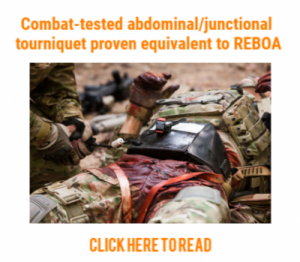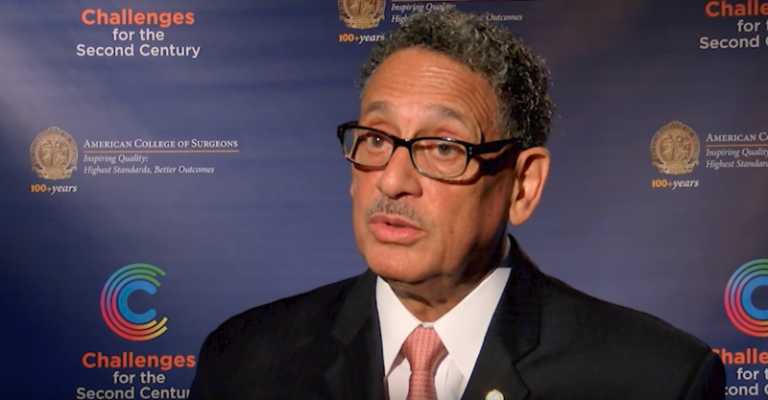Recent mass casualty incidents in the U.S. have changed the way we think about traumatic injury. Trauma leaders now know that the key to survival for many victims is immediate bleeding control provided by first responders or private citizens.
According to Lenworth Jacobs, MD, MPH, FACS, chairman of the Hartford Consensus and leader of the ACS Stop the Bleed Program, more than half a million people have received hemorrhage control training in the last two years. And while the percentage of Americans who know how to use a tourniquet is still small, there is good reason to believe their training provides a protective effect at the population level against the risk of bleeding out.
Dr. Jacobs will discuss the Stop the Bleed program during his keynote address at this year’s Creighton Trauma Symposium in Omaha, Nebraska. Recently, he spoke with Trauma System News about Stop the Bleed’s origins, goals and accomplishments.
Q. Could you explain the origin of Stop the Bleed?
Jacobs: This all started about five years ago after the Sandy Hook incident. At Hartford Hospital, which is a Level I trauma center, we were put on alert to respond to that incident — but then about half an hour later we were shut down. We thought that was because there was no problem needing us. But it turned out there was a gigantic problem which didn’t need us. And that was just overwhelming, primarily because the victims were six-year-olds. The senselessness of that was just overwhelming.
Very shortly after that, I was at a meeting of the Board of Regents of the American College of Surgeons. We agreed we needed to do something about this, so the college commissioned a committee to look at increasing survival after these incidents. And this became the Joint Committee to Create a National Policy to Enhance Survivability from Intentional Mass Casualty and Active Shooter Events.
Q. What was your key finding?
Jacobs: It immediately became clear that these kinds of events are multidisciplinary events. The first thing is that law enforcement goes in, and their mission is to secure the scene and preserve the evidence of the crime. Fire/rescue then goes in, and their mission is to put out fires and rescue people. And then the third to go in is emergency medical services, and their mission is to render emergency medical aid.
So it is very sequential, and the three groups usually have completely different governance systems, different communication systems and different “rules of engagement” and operation. That works just fine if you have a law enforcement event or a fire event or an emergency event. But it doesn’t work very well when all three of those things are happening simultaneously.
Q. So what’s the solution?
Jacobs: Since these active shooter and intentional mass casualty events are multidisciplinary events, that means they cannot be solved by one group. It’s a three-legged school.
The first leg of the stool is law enforcement. We actually took a page from the military and the Tactical Combat Casualty Care group. The Navy SEALs, for example, use a buddy system. If a soldier goes down, the person right beside him stops what he’s doing for the minute and first addresses the bleeding before calling in the medics. So we were able to get law enforcement to modify their mission to include hemorrhage control. Previously, if you were bleeding it really wasn’t the mission of law enforcement to stop your bleeding. But if you want to make bleeding control a part of their mission, (1) you have to train them to help stop the bleeding and (2) you have to equip them to stop the bleeding.
The second leg of the stool is EMS. They don’t have protective equipment, they’re not trained to go into hostile areas, etc. So their mission was typified at Columbine, where EMS providers were held back for 40 minutes and injured people died. You want to bring emergency medical services closer to the scene and employ them earlier on in the event. So the second leg was to bring EMS closer to the scene — not into the hot zone or the danger zone — but into the warm zone, which is not totally secure but you can begin treatment there. EMS can then later move the patient into the cold zone, where you can do triage and more defensive treatment.

So then our mission has to include informing and then educating and then empowering the public to be an immediate responder in this area. That is the third leg of this stool, and it is equivalent to if you see someone drop down from a heart attack, society says it’s okay for you to do CPR. And it’s not only okay, it’s a good thing for you to do. Similarly, if the person beside you is bleeding to death, we want you to be empowered and educated to do your best to stop that bleeding.
Q. Which brings us to the mission of Stop the Bleed…
Jacobs: So that next mission was to develop an educational program which could allow a layperson to become competent in stopping bleeding in a very short period of time.
We only teach three things — how to use your hands, how to use a hemostatic dressing and how to use a tourniquet. And that teaching process takes between half an hour and an hour. We give you an educational overview and then teach you how to use the equipment, and then you demonstrate it back to us and you’re good to go.
So that is the third leg of the stool, to create immediate responders in the lay public to stop bleeding — not just from an explosion or gunshot, but from any cause, because it is far more common for someone to be cut with a chainsaw, cut with a kitchen knife, fall on a stake, have a very bad motorcycle accident, etc. Those kinds of injuries are much more common than shootings or explosive events.
Q. Does bleeding control training “stick” months or years later?
Jacobs: That’s a good question. There is a very good study out in JAMA Surgery by a group at Brigham and Women’s Hospital in Boston. They found that three to nine months after people go through a Bleeding Control Basic (B-Con) course, there is about a 55% retention rate for tourniquet use.
[Editor’s note: See Effectiveness of Instructional Interventions for Hemorrhage Control Readiness for Laypersons in the Public Access and Tourniquet Training Study (PATTS): A Randomized Clinical Trial.]
So, yes, there is some loss of the skill set, no question about it. But you know, we have this thing called “herd immunity.” So say I teach ten people how to perform bleeding control. Even if half of them forget how to do it or don’t do it very well, the other half will retain the skill and probably be able to help the ones who have forgot. Will they be perfect? I don’t think so. But they will be effective, and all we’re really trying to do is keep the blood inside the body until you get to a trauma center. That’s all.
So you don’t really have to do anything definitive. You just have to keep the blood inside the body. Just stop the bleeding. You don’t have to fix it, just stop it.
Q. Do people seem willing to do this?
Jacobs: There is definitely a willingness on the part of the public to be helpful. We know that. We did a survey and it showed that 92% of people said they were willing to help somebody who was bleeding. So there’s a tremendous wellspring of altruism in the public as evidenced by all these events. Whether it’s Boston or Las Vegas or Orlando or wherever, people want to be helpful. We just need to train them and inform them and empower them so if they try to be helpful, they can go ahead and be helpful.
Q. What is the takeaway for trauma professionals who hear you at the Creighton symposium?
Jacobs: We want the group that’s coming to the Creighton Trauma Symposium to understand this message, to recognize that Stop the Bleed is an important thing and a public good. And then we want them to learn how to perform bleeding control and become teachers for the general public. If they learn how to do it and then go back to their home communities and become trainers of the trainers, then the message escalates exponentially.
Q. Ideally, everyone would learn how to control bleeding. What is the progress so far?
Jacobs: There are more than 300 million people in the country, so it’s a daunting task. But in the last year to year and a half, we have trained 20,000 instructors in all 50 states and 68 countries. We have also provided basic bleeding control training to 300,000 or 400,000 law enforcement officers, the entire FBI and probably well over 200,000 citizens, and that is an underestimate. So it’s a start. As you like to say, it’s a grain of sand on the beach, but it’s an important grain of sand.


2 Comments
…incredibly, some professionals still recoil at the idea of building the public (specifically the lay) population’s ability to respond to severe bleeding?!
EMS cannot/will not be able to intervene every time within the three minutes I could bleed to death in. That is a reality of response times.
I have already taught my CHILDREN an appropriate continuum of care for such severe bleeding events…pressure if appropriate, tourniquet as needed, second tourniquet as needed, wound packing and pressure in junctional areas with hemostatic gauze dressings, etc….
If I can get my 5th grader to demonstrate conceptual understanding and practical application, why are we really questioning the appropriateness of educating the public?
Some report concern for nerve damage from tourniquet use…REALLY? An appropriate review of literature shows nerve palsy to be a very small concern. At the end of the day, one has to decide whether salvation of LIFE takes precedent over potential tissue injury or nerve damage.
Instead of fretting over statistically small concerns like potential nerve palsy, perhaps we should focus on teaching the lay person to identify and effectively stem severe blood loss- be it with direct pressure, tourniquet or otherwise.
Thanks for the comment, Joe!